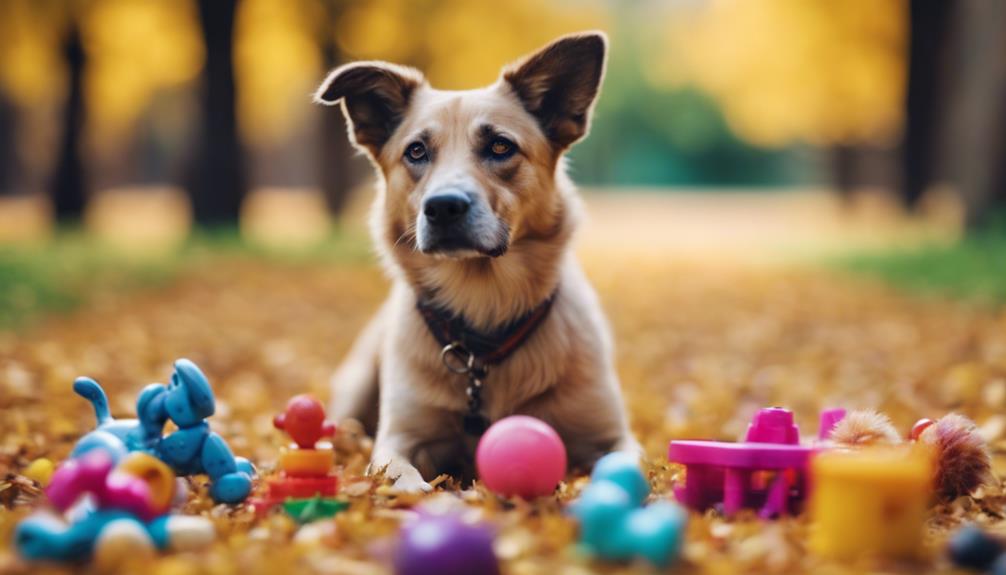The inquiry into dogs' ability to perceive color has sparked a wealth of research and speculation, prompting a closer examination of these animals' visual world.
As we delve into the complexities of canine color vision, a fascinating realm unfolds, revealing a distinctive perspective shaped by their unique sensory perceptions.
By unraveling the enigma of color blindness in dogs, we uncover a rich tapestry of insights that not only illuminate the way dogs interact with their environment but also hint at the profound implications for our understanding of these loyal companions' visual experiences.
Key Takeaways
- Dogs have limited color perception, seeing in blue and yellow hues.
- Dogs do not see red or green colors like humans.
- Dogs' vision is optimized for low-light conditions.
- Understanding dogs' color vision aids in selecting suitable toys and equipment.
Color Receptors in Canine Vision
In canine vision, the color receptors in dogs are limited to two, which restricts their color perception to shades of blue and yellow. Dogs lack the red and green color receptors present in human eyes, leading to a color vision spectrum similar to red-green color deficiencies in humans.
Consequently, dogs perceive the world in a range of muted hues, where bright red objects may appear brown to them. This restricted color perception influences aspects such as toy preferences and visibility of agility equipment.
Understanding this limitation in dogs' color vision can assist in designing toys and equipment that cater to their visual capabilities, enhancing their overall experience and interaction with the environment.
Perception of Color in Dogs
With their limited color perception, dogs primarily distinguish the world through shades of blue and yellow, lacking the ability to see red or green hues. This restricted color vision is due to dogs having only two color receptors, making their color spectrum different from humans. In a dog's view, colors appear as muted tones, with red objects often appearing brown. The table below summarizes the key points related to dogs' perception of color:
| Aspect | Details |
|---|---|
| Color Perception | Limited to blue and yellow hues |
| Missing Colors | Unable to see red or green hues |
| Color Appearance | Colors appear as muted shades |
| Red Objects | Red objects seem brown to dogs |
| Comparison to Humans | Similar to red-green color deficiencies |
Impact on Toy Preferences

Understanding dogs' limited color perception significantly influences their toy preferences. While dogs may not see colors the same way humans do, their toy choices can still be influenced by certain factors:
- Dogs are attracted to toys based on movement and scent rather than color.
- Toys in shades of blue and yellow are easier for dogs to distinguish.
- Brightly colored toys may be more appealing to human owners than to dogs themselves.
- Dogs may show a preference for toys that have a contrasting color with their surroundings, aiding in visibility.
Comparing Human and Canine Vision
A comparison of the visual systems of humans and dogs reveals distinct adaptations for different lighting conditions and color perception.
Humans possess three types of cones that allow for full-color vision across the spectrum, while dogs only have two types of cones, limiting their color perception to blue and yellow hues.
In contrast to humans, dogs have evolved with more light-sensitive rods in their retinas, enhancing their vision in low-light conditions. This adaptation enables dogs to see well in the dark, making them proficient at detecting movement and navigating nighttime environments.
While humans excel in color discrimination, dogs' vision is optimized for detecting motion and shapes, showcasing the unique evolutionary pathways that have shaped their visual capabilities.
Functional Aspects of Color Vision

Optimizing toys and equipment for dogs requires a nuanced understanding of their color perception and functional aspects of vision.
- Dogs' color blindness is not a result of eye deficiency.
- Both humans and dogs possess cones and rods for vision.
- Dogs' vision is tailored for low-light conditions.
- Their vision in the dark aids in efficient navigation and movement detection.
Marketing Strategies and Color Perception
In the realm of marketing pet products, the strategic use of colors takes on a crucial role in appealing to human consumers, despite dogs' limited color perception abilities. While dogs primarily see in shades of blue and yellow, marketers often leverage bright and varied colors to attract human buyers.
Although dogs may not distinguish between colors like red and green, humans are drawn to vibrant hues when selecting pet gear. Dog trainers and enthusiasts opt for equipment in blue or yellow tones as they stand out more prominently to dogs.
Understanding the disparity between human and canine color perception is essential for designing effective marketing strategies that cater to both human preferences and dogs' visual capabilities.
Conclusion
In conclusion, the limited spectrum of color perception in dogs, characterized by the ability to distinguish primarily blue and yellow hues, significantly impacts how they interact with their environment and perceive the world around them.
By understanding the differences in color vision between humans and dogs, we can better appreciate the unique visual perspective that dogs possess. This knowledge can inform toy preferences, marketing strategies, and overall interactions with these beloved companions.




